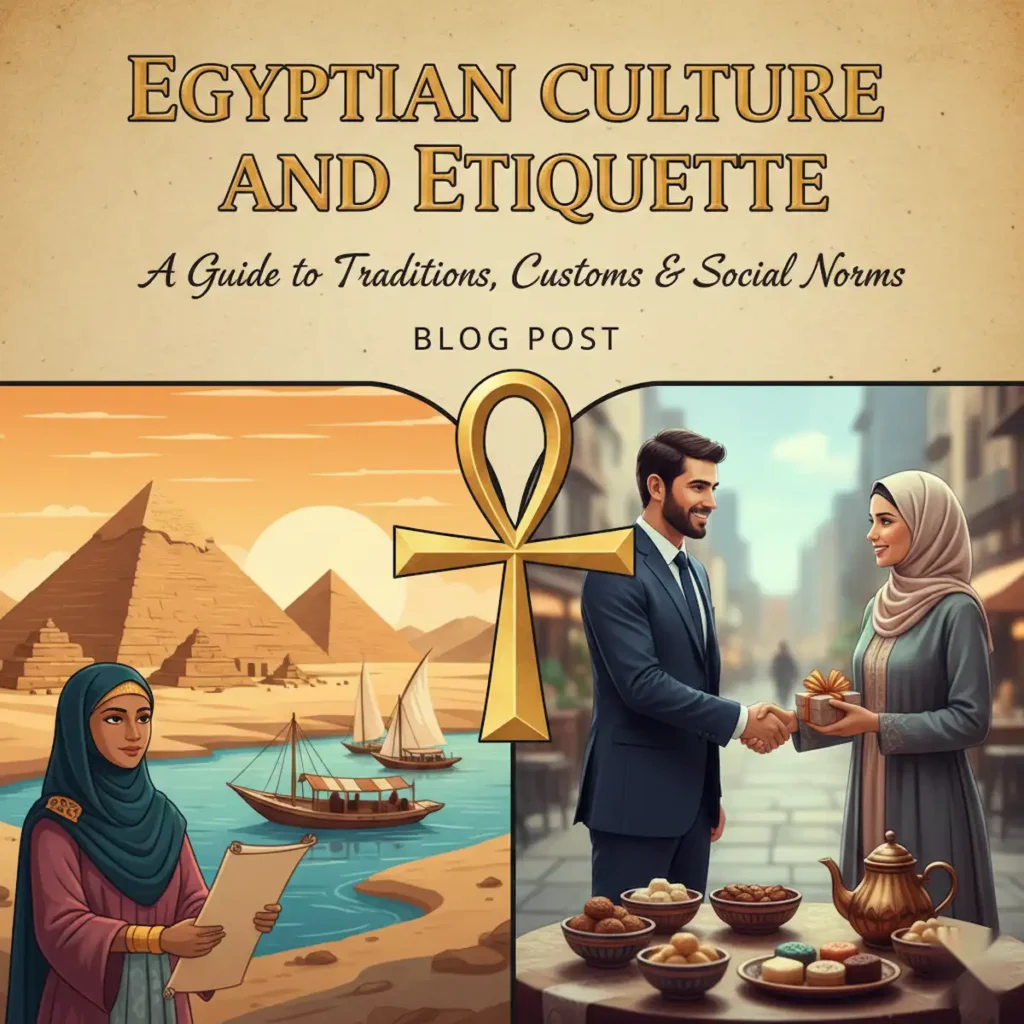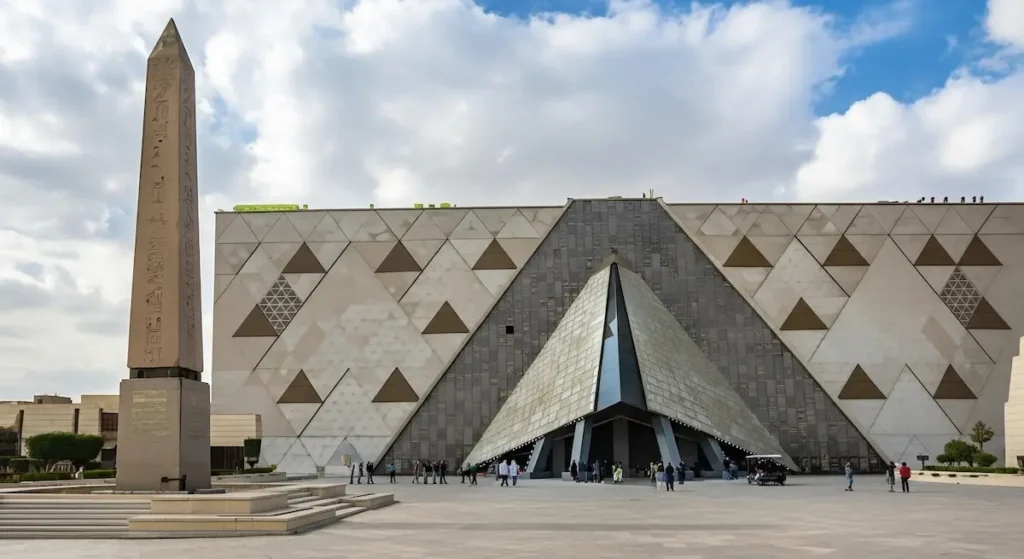Luxor Temple Guide
Luxor Temple Guide: History, Highlights, and Travel Tips for Visiting Egypt’s Iconic Landmark
1. Why Luxor Temple is a Must-See in Egypt
Overlooking the East Bank of the Nile stands the Luxor Temple, which is among Egypt’s most significant temples. In contrast with most monuments, Luxor Temple is not dedicated to gods but to kingship renewal, making it distinguished and significant. There is no full guide to Luxor Temple that will say it does not deserve this mention, and the person is destined to enjoy a tour of the old city.
It was built by King Amenhotep III, but Ramesses II added to satisfy. Luxor Temple remains one of the finest examples of ancient architecture in the world. You should come here to gaze at the monstrous statues; overwhelming hieroglyphs! And believe me, there is a street of Sphinxes running all the way from Luxor Temple to Karnak Temple, so you must cross this!
An elaborate guide to the Luxor Temple will show off not just the huge pylons and obelisks but also the mosque of Abu Haggag, creating another fascinating living dimension to the site. Really, if you see the place during the sunset or at night-time when the temple is beautifully lit up, the experience turns into something unforgettable.
Every travel plan must include it, and not to speak of it, rather to miss Luxor Temple’s visit, actually. Most Luxor Temple Guides and Best Things to do in Luxor express that it is a place that cannot be skipped and is certainly correctly termed as most probably capturing the very soul of ancient Thebes.
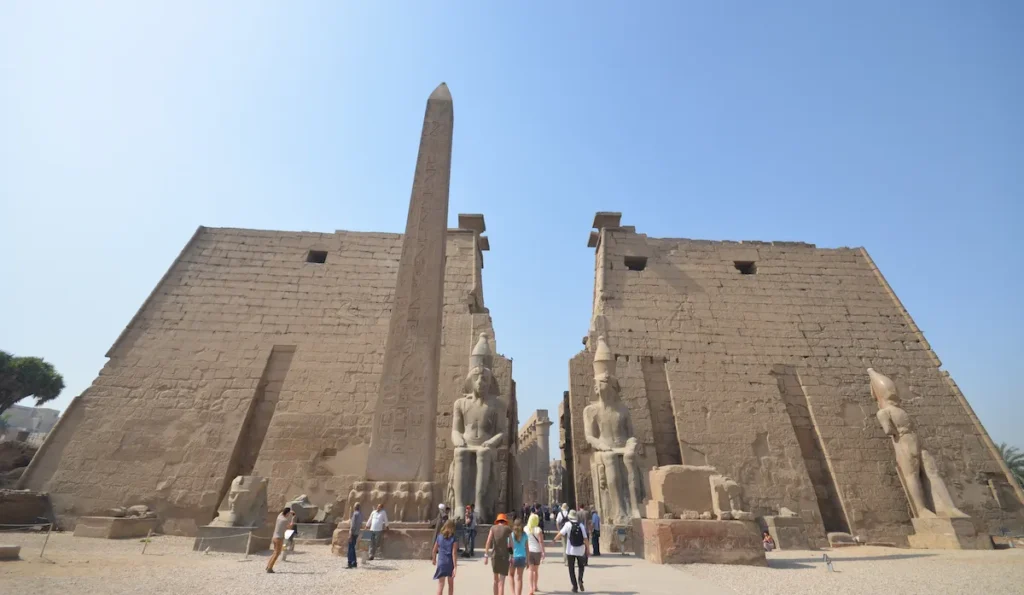
2. A Brief History of Luxor Temple
Situated in the heart of ancient Thebes, Luxor Temple is an iconic monument and a major attraction in any guide to Luxor Temple. In contrast to nearly all temples designed for the worship of some divinity, Luxor Temple was constructed to celebrate the rejuvenation of kingship. Over centuries, it was considered a sacred place for the coronation of pharaohs and for celebrating the divine kingship and associated rituals.
It was built during Pharaoh Amenhotep III’s time, 14th century BC, and then expanded by Ramses II; again, the giants of stone vigilance dominate the entrance till today. Other rulers, for example, Tutankhamun and Alexander the Great, left their marks on the temple, with their inscriptions, inscribing and chiseling some chapels. These are stretches spanning the journeying time over which the treasures of time accumulated, enriching the temple in its significance and meaning even through the passage of dynasties.
As a site of the Opet Festival, of course, Luxor Temple was a grand place for the movement of these deities, Amun, Mut, and Khonsu, from the Karnak Temple, through the Avenue of Sphinxes, and into Luxor Temple. This annual affair brought together the gods and pharaohs.
But today, when you stroll through the Temple of Luxor, it will feel as if you’re stepping back in time, experiencing the history of Egypt, where one layer of religion, politics, and culture melts into the next, all into one breathtaking place.
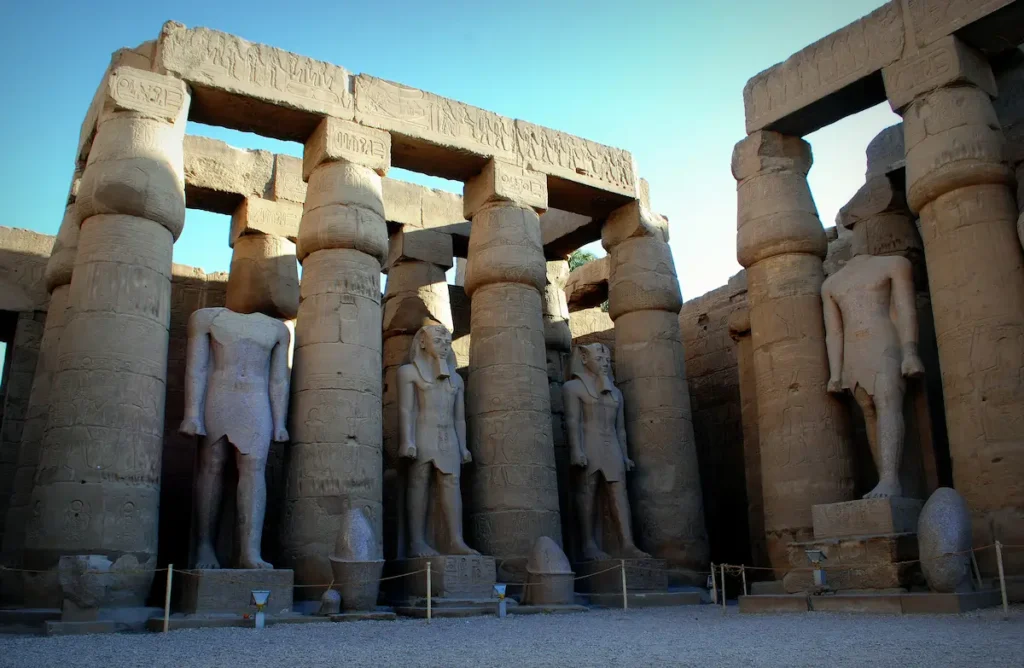
3. Architectural Wonders and Highlights Inside the Temple
Luxor Temple is described to be so grand; it is one of the most amazing monuments located in Egypt. This place is truly to see as a must-see and to be visited once visiting Thebes in the old times. Unlike any other temple that is dedicated to gods, the Luxor Temple was built in the name of renewals of kingship, and it is made so unique in form and purpose.
It was built with Amenhotep III but got restored and expanded by Ramses II; some of the fascinating features of the site are colossal statues, grand courtyards, and the prestigious Avenue of Sphinxes connecting it to the grand Karnak Temple. Any Luxor Temple Guide would never miss this spot because the mosque of Abu Haggag is seen here, which is symbolizing thousands of years of continuous prayers.
By day, the visitor may feast their eyes on the greedily darting of emitted light that pollutes the relief work and the large-scale monumentality of the buildings, while by night, the columns, which look through and through impressive, are transformed into magic features. Luxor Temple is replete with interest for any would-be visitor or tourist in the history of architecture and even photography. It avails, in fact, of the very essence of ancient Egypt and continues to constitute one of the most unforgettable attractions along the East Bank.
-
Colossal Statues of Ramses II
Every aspect of the Temple of Luxor is quite impressive. You can locate not just two entrance statues among them that are immense, but also depending on the sculptures on their size. Grandiosely seated beneath this size seating is immortalized the might and sanctity of probably the most potent pharaoh of Egypt. Like the best imaginable sitting upon the Empire State Building, a monument as infinite as Ramses II.
The temple guide outlines these statues for their handiwork and magnitude, the pillars that once roamed over with Zeitgeist but now beat with ample grandeur are ravaged by time.
They are also intimidating in size, the 60-feet-tall hallmark feature from that single solid, unusually splendid sandstone monolith that takes all the breath away in the world for a traveler-even for those who have roamed over the world. As members stand face to face with the giants, they can feel the heritage that really was produced by Ramses II with these members in a condition of experience incommunicable at the temple of Luxor itself.
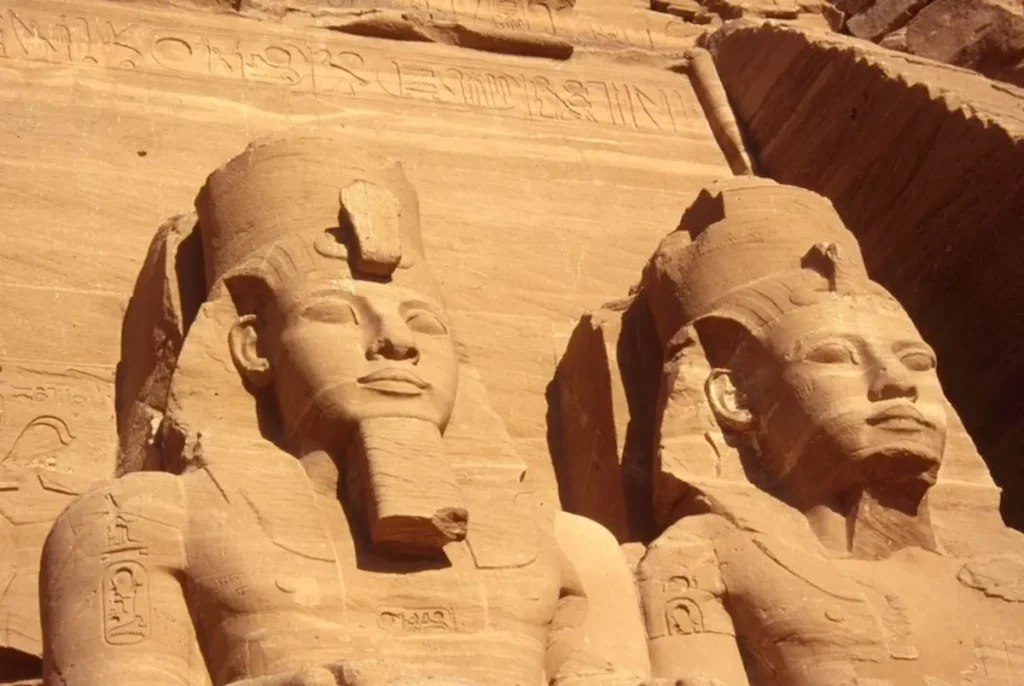
-
The Avenue of Sphinxes Linking Karnak to Luxor Temple
One of the most intriguing Luxor Temple attractions is the Avenue of Sphinxes road used many millennia ago for the Opet Festival, an annual event that connected Luxor and Karnak through nearly two miles. It had an impressive pathway lined on either side with sphinxes that were meant to be used only during Opet for the gods Amun, Mut, and Khonsu to be escorted on a walk from Karnak to Luxor.
For the longest time, the road lay hidden under gritty sand until cleared by determined excavations, finding long stretches of these guardian sphinxes, many of the statues still standing in good condition. This pathway still captivates imagination, imagining once again the splendor of such grandiose Egyptian celebrations and rituals.
In every Luxor Temple Guide, the Avenue of Sphinxes is mentioned because it must be seen as it combines spiritual and architectural unity between the two most important temples of Thebes, underlining Egypt’s rich traditions of ceremonies.
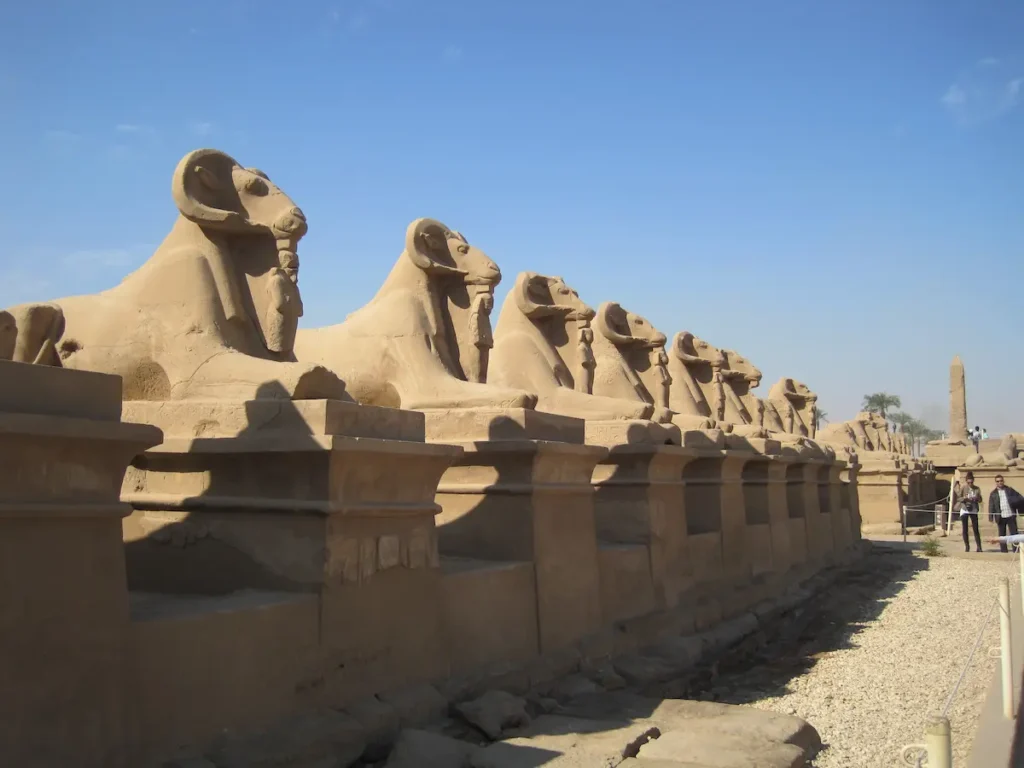
-
The Mosque of Abu Haggag: A Living Monument
Luxor Temple is distinct in many ways from its Mosque Abu Haggag, being one of those that stands directly on top of the old construction. The mosque remains an active house of worship even to this day, having been built in the 13th century, and appears to subsist not only as an ancient monument but endangeredly so as a living one to continue service to God.
It is about Abu Haggag, a revered Sufi saint, and his annual festival, which is celebrated even today in Luxor. What makes this site unique is the seamless co-existence of Islamic and Pharaonic architecture, where one comes across periodic columns, hieroglyphs, and statues amongst an Islamic arch and prayer spaces.
Luxor Temple does quite well to illustrate through every guide exactly this, so that continuity in cultures and religion is extolled. Visitors often feel awestruck by how spaces have been repurposed and reimagined, which speaks to the timeless nature of Luxor in being and remaining a center of spiritual life.
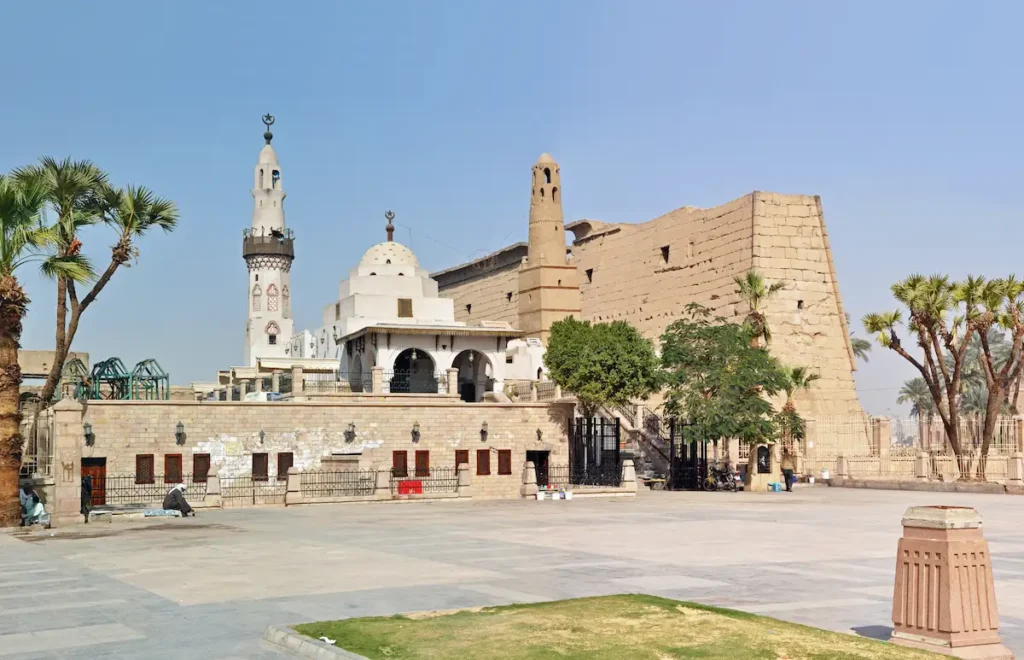
-
Obelisks and Their Global Journey
Standing at the entrance of the Luxor Temple were typically massive obelisks, each carved from single pink granite and towering aloft to nearly 25 meters in height. Their gigantic image was supposed to embody the authority of Ramses’s divinity, to show homage to the gods also. Nowadays, only one obelisk stands at the Luxor Temple, with its companion transported to France during the 19th century and proudly placed at the Place de la Concorde in Paris. It serves as one of the monuments that show the vast cultural legacy of Egypt.
There are many grand and fascinating stories, besides the great love of monuments, which attracts people in this world who always travel long distances to see them. For a traveller who is to notice this story, it is significant to be included in a Luxor Temple Guide. Being by the remaining obelisk, one would not only see the measuring but art it has while passing thought of its transnational importance.
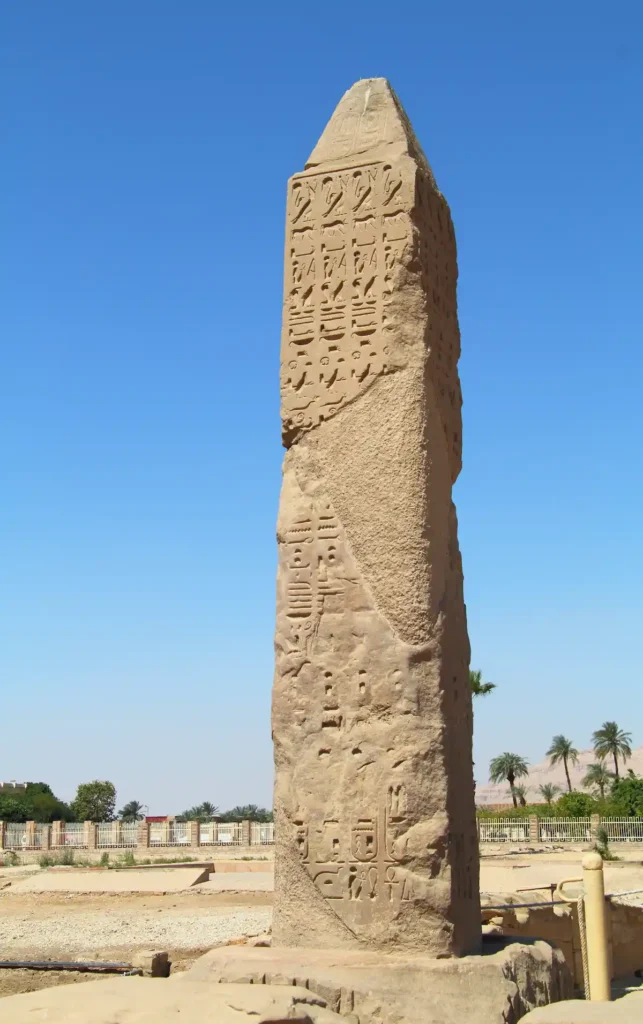
4. Best Time to Visit Luxor Temple for Stunning Views
The time you decide to visit Luxor Temple can transform an average experience into a meaningful one that you will never forget. But many believe the Luxor Temple is one of the Best Things to do in Luxor, then knowing when to go can also enable them to fully appreciate its beauty. You can read more about the Best Time to Visit Luxor with Family.
In the mornings, there are very few people, but the light is not so harsh, giving some soft light for photography. It is a time when the sun’s light casts gold on statues and columns, and it’s a quieter time of the day to travel around.
The late afternoons are entirely different, when the temple bathes in warm tones as the sun dips and illuminates and defines the detailed carvings. For those dramatic photos, that would be the perfect time with the larger-than-life images of Ramses II.
However, true charm comes at night, when the temple is illuminated. Walking under the glow of the columns under the stars-this almost defines the meaning of the duration that a Luxor Temple Guide has. With romance and a touch of mystique toward one of only a few sights that can offer such a feast in Egypt, the feeling remains sublime.
Irrespective of whether the visit is at dawn, dusk, or in the late hours of the night, Luxor Temple is a spot that promises to reward visitors with views and experiences they will cherish for a long time, more than satisfying those who love history, are into photography, or just search out the essence of old Egypt.
5. Practical Visitor Information: Tickets, Hours & Location
If you intend on visiting the Luxor Temple, then keep in mind that it’s open from 10 AM to 5 in the evening. Just a walk from the Corniche is also the west bank of the Nile, where the sights are really valuable to see. While in Luxor and the Valley of the Queens or Kings, you must take a ferry across the river, which will only take you a couple of minutes.
It is significantly less crowded here at dusk because most tourists are nearby in the part of the city termed the “museum zone.” When things get exciting and the sunset is really amazing, you know where everyone will be-so make sure you take pictures at that time.
20-something Egyptian men hang out here, as they even offer ad hoc carriage rides, but it is a really casual environment, and if you’re a woman, you can actually be among them together with their children. Singled-out independent travelers are favored here. In a more highbrow area, such as the Port area or Western Tourist Village, women can come to relax socially, but won’t hang with a bunch of single friends.
Opening Hours: Luxor Temple is open daily from 6:00 AM and will go right on through until 10:00 PM. Beyond here, the East Bank is one long strip directly against the Nile at the end of which, facing Luxor, is the Ramesseum tomb complex.
Entrance Fees: As of today, the full-price entrance for all adults is set at 160 EGP or $10 USD, while students holding valid IDs pay less for the entrance. You might want to contact the official entrance or some tourist information boards for the very latest prices.
Due to the fact that Luxor Temple is centrally located, it is just close enough to walk from the majority of hotels around town, but walking can also cut down on a lot of time for some sightseers. This makes the city an attractive walking city, especially when most people can just browse around parts of the city that are within a stone’s throw.
Landing early during the peak season when it is hot and crowded in the afternoon, is very important advice in all detailed Luxor Temple Guides. A full East Bank experience can be achieved by combining a visit to Karnak, just a short ride away.
6. Travel Tips for Visiting Luxor Temple
A visit to Luxor Temple is one of the Best Things to do in Luxor, but a few smart tips can make your experience smoother and more rewarding.
Dress Comfortably and Modestly: Egypt can be very hot, especially midday. Lightweight, breathable clothing, a hat, and sunscreen are essential. Since Luxor Temple is also a sacred site with the Mosque of Abu Haggag, modest attire shows respect.
Hire a Guide or Use an Audio Tour: The temple’s walls are filled with hieroglyphs and carvings that tell fascinating stories. A professional guide or a reliable Luxor Temple Guide app can bring the history to life in ways you might miss alone.
Photography Tips: For the best photos, visit early morning or late afternoon for soft light. Night photography is also magical, with the illuminated colonnades creating dramatic effects.
Avoid Peak Heat and Crowds: Plan your visit early in the day or after sunset. This not only helps with comfort but also makes exploring more enjoyable.
Combine Visits: Since Luxor Temple is close to the Corniche, many travelers pair their visit with Karnak Temple or enjoy a Nile-side dinner afterward, a perfect way to end the day.
7. FAQs About Luxor Temple, Egypt
What to Wear & Photography Advice
Luxor’s climate is hot most of the year, so lightweight, breathable clothing, comfortable walking shoes, and a hat are essential. Modest attire is recommended, especially since the temple houses the active Mosque of Abu Haggag. For photos, aim to visit early morning or late afternoon when the sun casts softer light on the statues and columns. At night, the temple is beautifully lit, offering magical photography opportunities.
Exploring with a Guide vs. Going Solo
While wandering alone allows flexibility, hiring a licensed Egyptologist or using an audio Luxor Temple Guide enhances your visit. Guides explain the symbolism behind carvings, statues, and chapels, transforming the site from ruins into a living story of ancient Thebes.
How to Combine Luxor Temple with Other Attractions
Thanks to its central location on the East Bank, Luxor Temple pairs perfectly with nearby highlights. Many travelers visit Karnak Temple on the same day, connected by the historic Avenue of Sphinxes. After exploring, enjoy a rooftop dinner overlooking the Nile, a relaxing way to end your tour of one of the Best Things to do in Luxor.
8. Luxor Temple at Night: A Magical Experience
After all, during the day at Luxor Temple, the monument can translate as really startling, but experiencing the place at night can mean a completely new sensation. The sun sets and creates another scene by lighting the grand statues, huge columns, and little inscriptions, carvings that transform the temple into an almost timeless dream place. An evening spectacle is identified as one of the Best Things To Do In Luxor, especially for those witnesses in history who have awakened from the dead.
Playing under those cascading shadows from the golden lights accentuates the mammoth statues of Ramses II, the majestic obelisks, and the Avenue of Sphinxes, as the whole place looks enigmatic. Compared to daytime, it gives me silent and private moments to walk through the temple at night for a less crowded visitation.
However, this arrangement could instead include an evening stroll along the Corniche, where visitors would go away with the glistening Nile under a bright moon. It could also be concluded by traveling to one of the Best places to eat in Luxor for an authentic taste of Egyptian food while contemplating the beauty of the overlooked temple.
Traveling alone, with friends, or on a guided tour, one must not miss Luxor Temple when the shades of evening are falling-the most magical way of understanding why, indeed, Egypt has had the most iconic heritage.
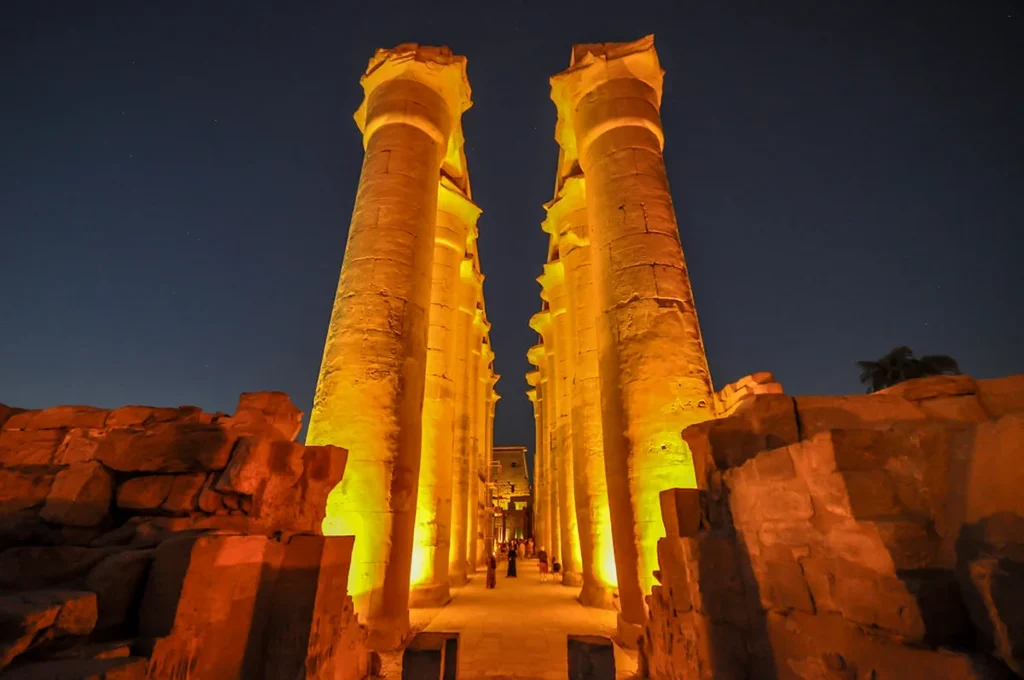
9. Luxor Night Tours Tips
The best things to do and go to Luxor are to experience Luxor at night because there are totally different facets of the ancient city you will need to see. It’s breathing cool air from the night and an amazing, vibrant atmosphere, and the monuments are being illuminated to make night tours magical in one`s itinerary.
The most popular evening activity in the city is the Sound & Light Show at Karnak Temple, in which the ancient grandeur is narrated again through dramatic use of lighting and voice. Suppose you are looking for more relaxing options. In that case, you can enjoy beautiful, casual evenings through the Corniche, near the Nile, especially after an exquisite dinner in one of the Best places to eat in Luxor.
Check for night tours in Luxor. Book a guided package that also includes transportation and admission-a time and energy saver. Additionally, many of these tours include dinner evenings with temple visits, providing a comprehensive cultural experience. One will need a light jacket, though, as it can get chilly once the sun sets, meaning one should also keep the camera ready on its own, as some of the belly-warming moments occur when the night temple is lit with a beautiful golden hue.
For those who are planning a new place to stay in Luxor, Egypt, the best choice would be the accommodation situated on the East Bank. This will make it easier for you to get some evening activities. The West Bank seems quiet and has more of a local ambiance.
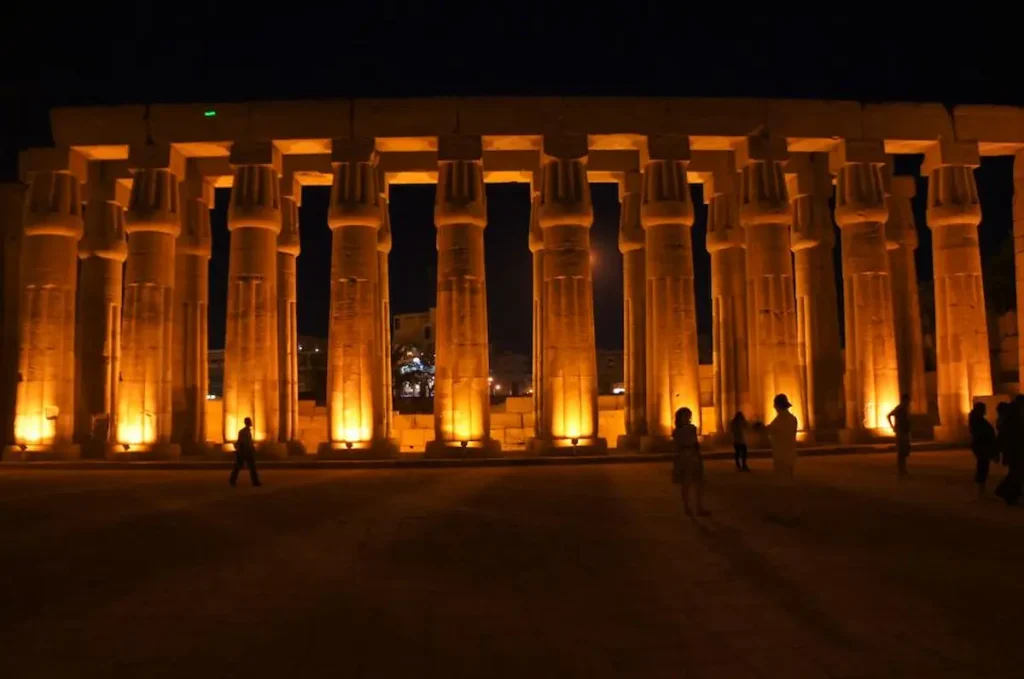
10. Final Thoughts: Adding Luxor Temple to Your Itinerary
No other trip to Egypt can be called a proper trip without visiting the Luxor temple. This ancient monument is more than just a historical site: it is living proof of Egypt’s eternal heritage. Massive statues of Ramses II, the Avenue of Sphinxes that formerly connected with Karnak, or the Mosque of Abu Haggag that still functions within its walls-thus the temple is an exclusive mixture of history, spirituality, and architectural wonder.
If you want to plan the Best Things to Do in Luxor, this temple should be at the top of your list. It is very close to the east-west and can easily be combined with other attractions such as Karnak Temple, the Valley of the Kings, or even a sunset felucca ride along the Nile. For the culture-hungry traveler, the temple guide of Luxor offers the broadest possible orientation in optimizing any individual visit.
You can see Luxor Temple once in a different perspective; you can witness the beauty of the temple in the golden sunset in the afternoon. Lights shine on it after sunset: this is the right time to see Luxor by visiting it in the evening. You can see an inside tour of the temple by a professional guide who will reveal many of its stories.


